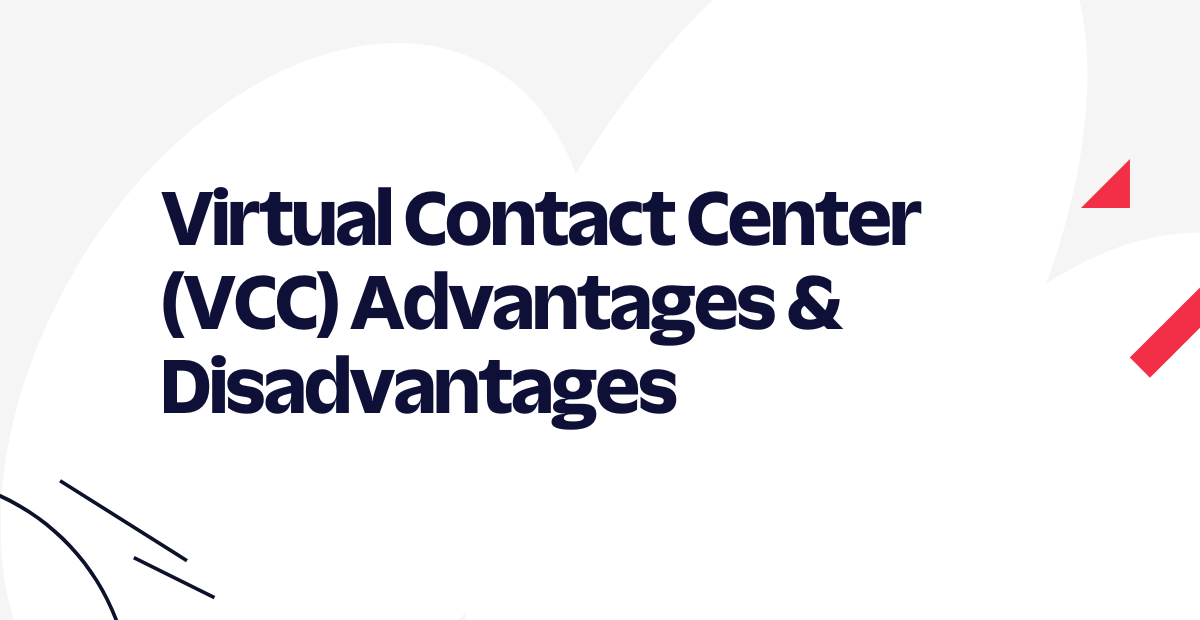Virtual Contact Center (VCC) Advantages & Disadvantages
Time to read: 5 minutes

When I think about virtual call centers, I think about DVDs.
Remember the time before streaming? If you wanted to watch a movie, you needed a disc, which usually led to row upon row of rarely watched movies taking up space. And if you started watching in the bedroom and wanted to move to the living room, you had to take the disc with you, put it in the other DVD player, and manually fast forward to where you left off.
That sounds exhausting to us now, right? How did any of us survive?
Now we have thousands of movies available on demand that we can seamlessly watch on dozens of different devices. The virtualization of movies made watching them more convenient and flexible.
Let’s apply that logic to call centers. Before virtualization, you had a big building full of agents placing and receiving calls. Agents had to be on-premise to work, and each had to use a single, specific desk phone.
It’s easy to see how virtualization could add convenience, agility, and flexibility to the call center. So what is a virtual call center, what does it look like, and why should you care? Let’s dig in.
What is a virtual call center?
A virtual call center (or contact center) is a call center supported by software, not by a physical location.
On-premise contact centers have outdated, expensive, inflexible hardware and data centers that require agents to work on-site. Virtual contact centers are the opposite, using cloud software that allows agents to work at home, in shared workspaces, or at regional offices. Plus, agents in a virtual contact center can collaborate without the physical limitations of an on-premise contact center.
How do virtual contact centers work?
Using proprietary software, on-premise contact centers take months to deploy and even longer to adapt to keep up with customer needs. On the other hand, virtual contact centers use cloud-based software that in-house developers can customize and deploy in a matter of days and continually adapt and scale as needed.
Since virtual contact centers store data in the cloud, agents don’t have to be on-site to access it. In fact, with a cloud-based contact center, agents can work remotely from anywhere with an internet connection. This allows virtual contact centers to offer support across locations and time zones at a lower cost than on-premise contact centers.
That’s just one of the many advantages we’ll dive into next.
What are the advantages of virtual contact centers?
The pandemic forced many businesses to go from physical office space to a virtual workforce. Thanks to this shift, businesses big and small realized that remote work is a lot more feasible now than it was even a decade ago, and that virtual call centers offer benefits to workers, customers, and business owners alike. A virtual contact center allows you to:
Reduce infrastructure overhead
A virtual call center reduces the cost of leasing office space, heating and cooling, internet connectivity, and other expenses that an on-premise contact center incurs.
Achieve higher call quality
In a virtual call center, agents place and receive calls through Voice Over Internet Protocol (VOIP) technology instead of landlines, which eliminates distortion, echo, and static from old copper wiring.
Integrate and customize
Since virtual call centers don’t rely on specific telephone models or private branch exchange (PBX) systems, it’s straightforward to integrate them with customer relationship management software, analytics, and more. With the right cloud contact center software, you can integrate your virtual call center with your existing processes and customize it to your use case.
Hire top talent
Virtual contact centers can hire the best people for the job—not just the best people who happen to live within commuting distance of the office. By offering remote work, this can also help your company stand out and attract top talent no matter where they are.
Improve employee experience
Eliminating commutes, traffic jams, and dress codes can go a long way in boosting employee morale, which can boost productivity and reduce agent turnover.
Enhance customer experience
When you can hire the best agents for the job and offer flexible employment that improves morale, employees are more likely to provide excellent customer service. Virtual call centers also make it easier for employees to share customer data internally and provide a seamless experience for the customer. Plus, you can conveniently track call center metrics to quickly evaluate and improve your customers’ experiences.
What are the disadvantages of virtual call centers?
While there are plenty of advantages to going virtual, there are a few unique challenges as well. Most of them you can address with the right virtual call center platform and a culture of communication and collaboration. Here are a few to consider. A virtual call center can:
Fuel employees’ feelings of isolation and a lack of communication
Working from home can be a major adjustment for those used to the social aspects of an office environment. Remote employees can feel disconnected from their coworkers and the organization.
That’s why it’s important to encourage a culture of communication and collaboration. By holding a daily or weekly video call to check in and make sure your employees know each other, you ensure they feel like part of the team and are comfortable raising concerns.
You can also encourage asynchronous communication through apps like Slack, Microsoft Teams, or a proprietary internal chat solution. Whichever instant messaging platform you choose, give coworkers the option to talk to each other without having to be online at the same time.
Create cybersecurity threats
Virtual call centers have more potential exposure to cyberthreats than a physical office building—it’s simply easier to protect an on-premise network than one with dozens or hundreds of access points.
Make sure your call center solution includes robust security to protect your customer data, employees, and business.
Require rigid software and a steep learning curve
Some virtual call center solutions lack programmability and configurability options, which can lead to longer onboarding time, endless workflow adjustments, and efficiency loss. Look for a call center solution—like Twilio Flex, which we’ll discuss next—that you can tailor to suit your unique needs, not one that tries to force you into a single way of doing things.
How do I get started with a virtual contact center solution?
Whether you’re looking for a brand-new solution or a replacement for your current virtual call center software, Twilio can help. Twilio Flex is the world’s most flexible virtual contact center platform, designed to integrate with and augment your existing workflow. You can deploy this agile platform in a matter of days and customize any aspect of your contact center to meet your customers’ and business’ needs.
Have we piqued your interest? Request a demo to see what you can build with Twilio Flex.
Related Posts
Related Resources
Twilio Docs
From APIs to SDKs to sample apps
API reference documentation, SDKs, helper libraries, quickstarts, and tutorials for your language and platform.
Resource Center
The latest ebooks, industry reports, and webinars
Learn from customer engagement experts to improve your own communication.
Ahoy
Twilio's developer community hub
Best practices, code samples, and inspiration to build communications and digital engagement experiences.

